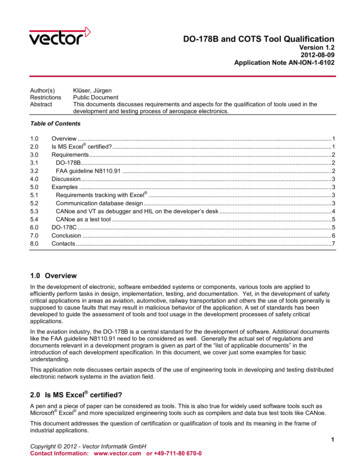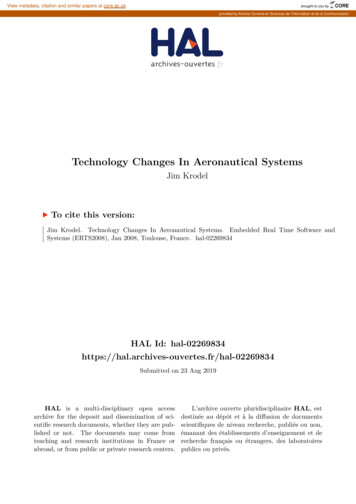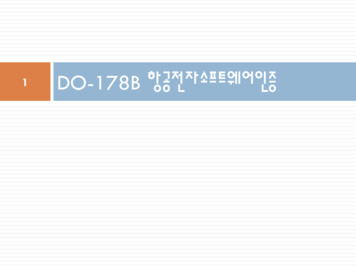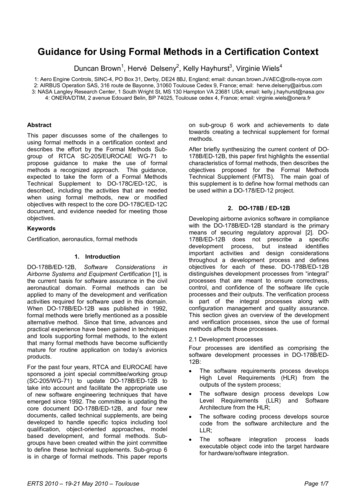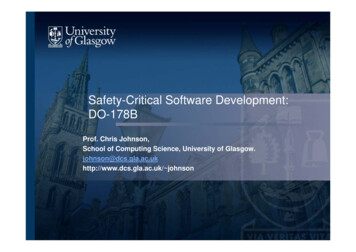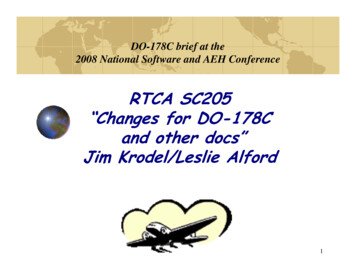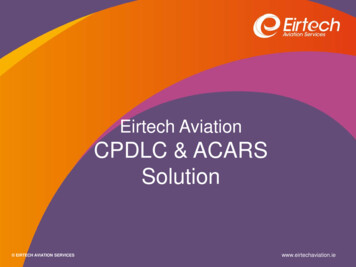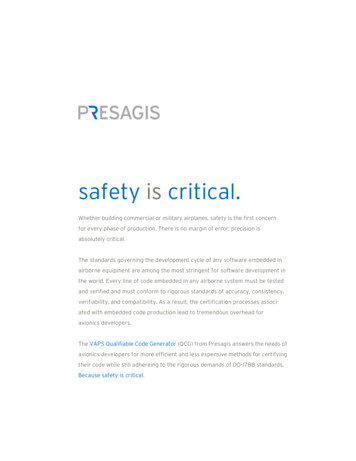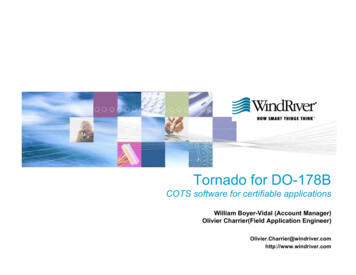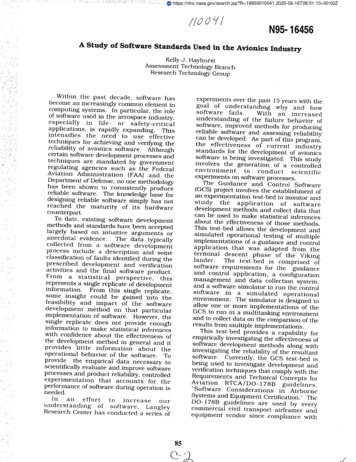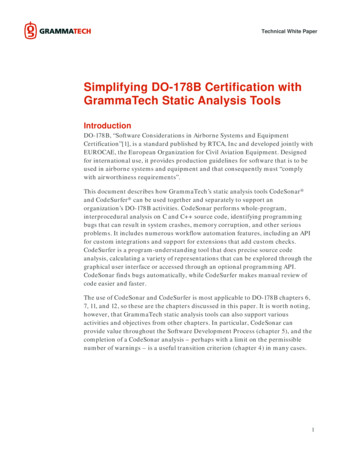
Transcription
Technical White PaperSimplifying DO-178B Certification withGrammaTech Static Analysis ToolsIntroductionDO-178B, “Software Considerations in Airborne Systems and EquipmentCertification”[1], is a standard published by RTCA, Inc and developed jointly withEUROCAE, the European Organization for Civil Aviation Equipment. Designedfor international use, it provides production guidelines for software that is to beused in airborne systems and equipment and that consequently must “complywith airworthiness requirements”.This document describes how GrammaTech’s static analysis tools CodeSonar and CodeSurfer can be used together and separately to support anorganization’s DO-178B activities. CodeSonar performs whole-program,interprocedural analysis on C and C source code, identifying programmingbugs that can result in system crashes, memory corruption, and other seriousproblems. It includes numerous workflow automation features, including an APIfor custom integrations and support for extensions that add custom checks.CodeSurfer is a program-understanding tool that does precise source codeanalysis, calculating a variety of representations that can be explored through thegraphical user interface or accessed through an optional programming API.CodeSonar finds bugs automatically, while CodeSurfer makes manual review ofcode easier and faster.The use of CodeSonar and CodeSurfer is most applicable to DO-178B chapters 6,7, 11, and 12, so these are the chapters discussed in this paper. It is worth noting,however, that GrammaTech static analysis tools can also support variousactivities and objectives from other chapters. In particular, CodeSonar canprovide value throughout the Software Development Process (chapter 5), and thecompletion of a CodeSonar analysis – perhaps with a limit on the permissiblenumber of warnings – is a useful transition criterion (chapter 4) in many cases.1
Typographical ConventionsThe following typographical conventions are used in this document. CodeSonar warning class names are rendered in italic, sans-serif font: NullPointer Dereference. If the warning class is disabled by default, the classname is marked with an asterisk: Recursive Macro*.Software life cycle data artifacts defined in DO-178B Chapter 11 arecapitalized: Software Design Standards.Direct quotes from the DO-178B document are formatted like thefollowing:“The rapid increase in the use of software in airborne systems andequipment used on aircraft in engines in the early 1980s resulted in aneed for industry-accepted guidance for satisfying airworthinessrequirements.”2
DO-178B Chapter 6: “Software Verification Process”“The purpose of the software verification process is to detect and reporterrors that may have been introduced during the software developmentprocesses.”GrammaTech CodeSonar and CodeSurfer bring powerful static analysiscapabilities to the Software Verification Process. DO178-B sections 6.3 (SoftwareReviews and Analyses) and 6.4 (Software Testing Process) describe verificationobjectives that are well supported by these tools, as described below.6.3 Software Reviews and Analyses“Reviews and analyses are applied to the results of the softwaredevelopment processes and software verification process. Onedistinction between reviews and analyses is that analyses providerepeatable evidence of correctness and reviews provide a qualitativeassessment of correctness.”It is useful to think of both CodeSonar and CodeSurfer as performing analyseswhose outputs can be used to inform manual reviews.6.3.3 Reviews and Analyses of the Software ArchitectureCodeSonar and CodeSurfer provide complementary support for architecturereview. CodeSurfer provides architecture visualization and sophisticated queryfunctionality, while CodeSonar’s built-in checks and extension capabilities allowmany architecture problems to be flagged automatically.“a. Compatibility with the high-level requirements: The objective is toensure that the software architecture does not conflict with the high-levelrequirements, especially functions that ensure system integrity, forexample, partitioning schemes.”Architecture reviewers can use CodeSurfer to inspect structural properties of thesoftware at a number of levels of detail. The CodeSurfer GUI allows interactivebrowsing of the various structural elements, while the optional programming APIprovides automation capabilities and broad potential for customization. BothGUI and API provide powerful built-in queries, such as slicing, that can be usedto check the integrity of partitioning schemes.“b. Consistency: The objective is to ensure that a correct relationshipexists between the components of the software architecture. Thisrelationship exists via data flow and control flow.”CodeSurfer allows users to examine both control flow and data flow from anumber of perspectives. Among those most useful for inspecting the relationshipbetween software architecture components are the control flow graph and callgraph. The results of control- and data-related queries can be superimposed onthese graphs, providing a straightforward depiction of the dependences involved.3
“c. Compatibility with the target computer: The objective is to ensurethat no conflicts exist, especially initialization, asynchronous operation,synchronization and interrupts, between the software architecture andthe hardware/software features of the target computer.”Several built in CodeSonar checks can detect potential compatibility problems,including Uninitialized Variable, Double Lock, Double Unlock, Try‐lock that will neversucceed, and Shift Amount Exceeds Bit Width.“d. Verifiability: The objective is to ensure that the software architecturecan be verified, for example, there are no unbounded recursivealgorithms.”While demonstrating the complete absence of unbounded recursion is of courseprovably impossible in general, CodeSonar offers several checks that help reducethe likelihood that infinite recursion will occur. If the system architects choose toforbid recursion entirely, the Recursion* and Recursive Macro* checks can beenabled in order to detect violations. If recursion is to be permitted, the ExcessiveStack Depth* check can identify potential cases of runaway recursion. Similarly,CodeSonar’s Potential Unbounded Loop* check does not and cannot detect allinfinite iterative loops in all programs, but will identify many loops whoseboundedness cannot be established.“e. Conformance to standards: The objective is to ensure that theSoftware Design Standards were followed during the software designprocess and that deviations to the standards are justified, especiallycomplexity restrictions and design constructs that would not complywith the system safety objectives.”CodeSurfer computes many standard complexity metrics, whose values can becompared against limits set out in the Software Design Standards. The metricsare computed at the project, file, and function levels, allowing designers to easilyidentify problem areas.If system safety objectives are such that specific design constructs must berestricted or forbidden, custom CodeSonar checks can be written to issuewarnings whenever those constructs are encountered.“f. Partitioning integrity: The objective is to ensure that partitioningbreaches are prevented or isolated.”CodeSurfer allows users to trace both control and data through the variouspossible executions of a program. Users can obtain answers to such questions as“can data in region A influence execution in region B?”, “is there an executionpath between region C and region D?”, and “what are the callers of function F?”The optional Path Inspector extension to CodeSurfer can be invoked to confirm4
that execution flow from one part of the program cannot reach another part (and,if necessary, vice versa).Custom CodeSonar checks can also be used to detect partitioning breachesautomatically.Explicit control and data flow may not be the only avenues for breachingpartitioning requirements. In some cases other channels, such as the file system,must be considered. Designers may elect to forbid use of the file system entirely,in which case custom CodeSonar checks for uses of file-related functions and datatypes will be extremely useful. Alternatively, file usage may be permitted underrestricted circumstances, in which case the custom checks will need to verify thatthe appropriate conditions hold whenever files are used.6.3.4 Reviews and Analyses of the Source CodeSource code analysis is the most significant strength of both CodeSonar andCodeSurfer. A full accounting of the reviews and analyses supported by theseproducts is not possible in this space; instead we outline some key features.“b. Compliance with the software architecture: The objective is to ensurethat the Source Code matches the data flow and control flow defined inthe software architecture.”CodeSurfer provides powerful functionality for visualizing data and control flowin software, and for answering complex queries about both. Users can comparethe flow computed by CodeSurfer to that defined in the software architecture toidentify any discrepancies. CodeSurfer’s pointer analysis means that pointeraliasing and indirect function calls are accurately accounted for.If control flow requirements specify a particular operation sequence that must beadhered to, CodeSonar can be extended with a custom check that issues warningswhenever the operations appear out of order.“c. Verifiability. The objective is to ensure that the Source Code does notcontain statements and structures that cannot be verified and that thecode does not have to be altered to test it.”Both CodeSonar and CodeSurfer observe the normal build process for a softwareproject and use the information thus gained to construct an internalrepresentation that is then subjected to various analyses. The production codedoes not need to be altered in any way.“d. Conformance to standards: The objective is to ensure that theSoftware Code Standards were followed during the development of thecode, especially complexity restrictions and code constraints that wouldbe consistent with the system safety objectives.”5
CodeSonar provides significant support for upholding coding standards, boththrough built-in checks for standard rule sets such as Power of Ten[4] andthrough a rich API that allows users to implement custom checks in support oflocal code standards. 11.7 Software Design Standards and 11.8 Software CodeStandards detail the ways in which CodeSonar can support and enforce a widerange of software standards.“f. Accuracy and consistency: The objective is to determine thecorrectness and consistency of the Source Code, including stack usage,fixed point arithmetic overflow, resource contention, worst-caseexecution timing, exception handling, use of uninitialized variables orconstants, unused variables or constants, and data corruption due totask or interrupt conflicts.”CodeSonar performs a large number of correctness and consistency checks,including those for the following warning classes: Excessive Stack Depth*Buffer Overrun, Buffer UnderrunType Overrun, Type UnderrunCast Alters Value, Integer Overflow of Allocation SizeUninitialized VariableUnused ValueDeadlock, File System Race Condition6.4 Software Testing ProcessCodeSonar’s static analysis can detect several of the problems listed asidentifiable through requirements-based testing methods, and can help resolvequestions arising from test coverage analysis.6.4.3 Requirements-Based testing methodsStatic analysis is not a substitute for testing but a complement to it, and in somecases will find problems that tests miss.“a. Requirements-Based Hardware/Software Integration Testing”“b. Requirements-Based Software Integration Testing”.“c. Requirements-Based Low-Level Testing”CodeSonar can detect many of the “typical errors revealed by [these] testingmethod[s]” early in the software development process. The relevant CodeSonarwarning classes are shown in the following table.Error“Stack overflow.”“Incorrect initialization of variablesand constants.”CodeSonar Warning Class(es)Excessive Stack Depth*Uninitialized Variable, DoubleInitialization6
“Parameter passing errors.”“Data corruption, especially globaldata.”“Inadequate end-to-end numericalresolution.”“Incorrect sequencing of events andoperations.”“Incorrect loop operations”Function Call Has No Effect,Unreasonable Size ArgumentBuffer Overrun, Buffer Underrun, TypeOverrun, Type Underrun, MAX PATHExceeded, No Space for Null Terminator,Return Pointer to Freed, Return Pointerto Local, Use After Close, Use After FreeCast Alters ValueDouble Lock, Double Unlock, Try‐lockthat will never succeed, Free NullPointer, Null Test After DereferencePotential Unbounded Loop*6.4.4 Test Coverage Analysis“Test coverage analysis is a two step process, involving requirementsbased coverage analysis and structural coverage analysis. The first stepanalyzes the test cases in relation to the software requirements toconfirm that the selected test cases satisfy the specified criteria. Thesecond step confirms that the requirements-based test proceduresexercised the code structure.”CodeSonar and CodeSurfer can be useful in the resolution phase of test coverageanalysis, if this is required.6.4.4.3 Structural Coverage Analysis ResolutionStructural coverage analysis may reveal code structure that was notexercised during testing. Resolution would require additional softwareverification process activity. This unexecuted code may be the result of:.“.c. Dead code”“.d. Deactivated code”In some cases, a test suite may be unable to exercise a particular code regionbecause the region is in fact unreachable. If structural coverage analysisresolution is to include a diagnosis of dead or deactivated code, it can be useful tosupport this diagnosis with static analysis results.CodeSonar detects unreachable code as part of its standard analysis suite.Distinct warning classes Unreachable Call, Unreachable Computation, UnreachableConditional, Unreachable Control Flow, and Unreachable Data Flow identify the mostimportant element present in each unreachable region, providing the user withadditional information about the consequences of not executing the code.In some cases code is unreachable because it is guarded by a conditionalstatement that can only ever evaluate one way. CodeSonar’s Redundant Conditionwarning class is designed to identify such situations.7
CodeSurfer provides complementary information about code reachability atseveral levels of detail. Users can determine whether there are entire functionsthat are never called using the program call graph. At the statement level, apoint-mode forward slice from the program entry point will compute all codethat can be reached; any code not in this set is therefore unreachable.Note that both CodeSonar and CodeSurfer work by analyzing a specific build of asoftware project. To establish that code is unreachable under all applicable buildconfigurations (for example, unreachable on all target platforms, or under allpermitted preprocessor settings), the analyses must be applied to all these buildsand the results compared.DO-178B Chapter 7: Software Configuration ManagementProcessWhile CodeSonar and CodeSurfer are not themselves software configurationmanagement tools, they can interact with the Software configurationmanagement process in several useful ways.7.2 Software Configuration Management Process ActivitiesGrammaTech tools can be used in support of the following software configurationmanagement process activities.7.2.2 Baselines and TraceabilityWhere unambiguous labels have been assigned to configuration items,CodeSonar provides several powerful mechanisms for applying correspondinglabels to analysis artifacts generated for those items. When a labeledconfiguration item is analyzed with CodeSonar: The analysis can be annotated with the same label, either directly orretroactively.A user can manually annotate all warnings issued by the analyses with thelabel (all at the same time, if desired).A custom warning processor can automatically annotate each warningissued by the analysis with the label. With further customization,annotation can be restricted to a particular subset of the warnings, forexample only those that were issued for the first time (that is, not seen inany previous analysis).The flexible search in CodeSonar includes functionality that allows users to findall warnings that have a particular annotation, or that were issued by an analysiswith a particular annotation. The annotation capability thus provides directtraceability between a particular configuration item and the analysis results forthat item.8
From time to time it may be necessary to analyze projects in which differentcomponents have different configuration identifiers. CodeSonar can providetraceability even in this case: the only differences are that the analysis annotationwill need to include all relevant labels, and the warning processor (or person)responsible for annotating warnings will need to take each warning’s locationinto account when assigning its label.Similarly, when a baseline is established for a configuration item, CodeSonarannotations can be used to identify analysis artifacts associated with thatbaseline.7.2.3 Problem Reporting, Tracking, and Corrective ActionProblem reporting and tracking are key roles of CodeSonar. Each analysis of aproject issues a number (possibly zero) of warnings. As a project undergoes acycle of modification and re-analysis over time, the CodeSonar hub builds up ahistorical record. Information is kept about each analysis, including the warningsissued, files analyzed, build settings on which the project was based, andannotations made. At a finer-grained level, the “same” warning can be trackedover time, determining the analysis in which it first appeared and (if theunderlying problem is successfully fixed) the analysis in which it first went away.CodeSonar keeps all annotations for each warning (except for cases where ananalysis has been explicitly deleted), so a history of notes, prioritydeterminations, owners, and assessments is built up over time.The CodeSonar hub is not restricted to warnings issued by the CodeSonaranalysis. For example, CodeSonar ships with an example script that uploads thewarnings issued by a FindBugs [5] analysis to a CodeSonar hub; scripts thatupload analysis results from other tools with different output formats aresimilarly possible.Conversely, warnings issued by the CodeSonar analysis are not restricted to theCodeSonar hub. Custom warning processors can send analysis results to externaltools, and can be applied either at analysis time or retroactively to individualwarnings and groups of warnings. CodeSonar ships with a processor that createsa bug report concerning one or more CodeSonar warnings and submits it to aBugzilla[2] database.7.2.4 Change Control“e. Throughout the change activity, software life cycle data affected bythe change should be updated and records should be maintained for thechange control activity.”As described in 7.2.3 Problem Reporting, Tracking, and Corrective Action,CodeSonar by default keeps substantial records of past and present analysisresults and the relationships between them. In cases where these records must beexpanded upon, they can readily be exported in a variety of formats. Whentraceability between a particular change and the analysis of the changed software9
is important, CodeSonar provides several mechanisms for making the connectionexplicit; these are described in 7.2.2 Baselines and Traceability.7.2.5 Change ReviewJust as CodeSonar warning processors can be used to apply annotations towarnings (7.2.2 Baselines and Traceability) or to submit them to third-partytrackers (7.2.3 Problem Reporting, Tracking, and Corrective Action), they can beused to assign warnings to specified reviewers. During the early developmentstages, a warning processor might be configured to assign each incoming warningto the engineer who last modified the source file containing the warning. Later, awarning processor might use the software level of the affected code to assign apriority to each incoming warning and then assign it to an engineer ofappropriate seniority.DO-178B Chapter 11: Software Life Cycle Data“Data is produced during the software life cycle to plan, direct, explain,define, record, or provide evidence of activities.”The Software Life Cycle Data defined by DO-178B include Plans with activitiesthat can be accomplished using GrammaTech static analysis tools. In addition,several of the specified Standards can be supported or partially supported bythese tools.11.7 Software Design StandardsGrammaTech static analysis tools can be used to support and enforce a numberof the Software Design Standards listed in DO-178B section 11.7.“b. Naming conventions to be used.”As described in 11.8 Software Code Standards, CodeSonar users can authorcustom checks for violations of naming conventions.“c. Conditions imposed on permitted design methods, for example,scheduling, and the use of interrupts and event-driven architectures,dynamic tasking, re-entry, global data, and exception handling, andrationale for their use.”It is straightforward to write custom CodeSonar checks on the use of global dataor exception handling: such checks would inspect the internal representation andissue warnings whenever the relevant artifacts were observed (or observedoutside permitted contexts).“e. Constraints on design, for example, exclusion of recursion, dynamicobjects, data aliases, and compacted expressions.”10
CodeSonar ships with several checks that support design constraints, and can beextended to add others. The Recursion* and Recursive Macro* warning classesbehave as one might expect: CodeSonar issues warnings whenever functions (ormacros, respectively) are directly or indirectly recursive. Classes DynamicAllocation After Initialization* and Pointer Type Inside Typedef* are useful if thedesign constraints limit but do not fully exclude the use of dynamic objects. Ifdynamic objects are to be fully excluded, users can construct custom CodeSonarchecks that issue warnings whenever allocators are used. Similarly, theCodeSonar extension mechanisms allow users to write checks for violations ofrestrictions on data aliasing and on expression side-effects.“f. Complexity restrictions, for example, maximum level of nested calls orconditional structures, use of unconditional branches, and number ofentry/exit points of code components.”As with the design constraints, CodeSonar has built in checks in support of someforms of complexity restriction and can be extended to add checks for others.Excessive Stack Depth* warnings are issued when the function call stack exceeds aspecified size: this expands on the notion of restricting call nesting by taking intoaccount the size of the execution record for each call. Several built in CodeSonarchecks cover various forms of unconditional branch: Empty if Statement, Emptyswitch Statement, Redundant Condition, Goto Statement*, and Use of longjmp*. Userscan create custom CodeSonar checks for violations of other complexityrestrictions that might be included in a project’s Software Design Standards.11.8 Software Code StandardsCodeSonar provides significant support for upholding coding standards, boththrough built-in checks for standard rule sets such as Power of Ten[4] andthrough a rich API that allows users to implement custom checks in support oflocal code standards.“a. Programming language(s) to be used and/or defined subset(s).”The CodeSonar API provides access to the abstract syntax trees (ASTs) generatedfor an analyzed software project. Users can leverage this access to author customchecks that report errors when forbidden program features are used.“c. Naming conventions for components, subprograms, variables, andconstants.”Because the CodeSonar API provides full programmatic access to the internalrepresentation generated for its analysis, users can readily create custom checksfor naming convention violations and have these checks carried out as part of theCodeSonar analysis. Checks can be targeted to specific program entities so caneasily handle naming conventions that impose, for example, one set of rulesgoverning the permissible names for variables and another for functions.11
“d. Conditions and constraints imposed on permitted coding convention,such as the degree of coupling between software components and thecomplexity of logical or numerical expressions and rationale for theiruse.”Various code complexity metrics have become standard in software engineeringpractice. CodeSurfer computes and reports a number of these standard metrics,including the McCabe[6] and Halstead[3] metrics. CodeSonar will incorporatethis functionality in the near future.The AST access provided by the CodeSonar API is useful here, as in previouscases. Given an expression complexity limit specified by the Software CodeStandards, a user can create a custom check that issues a warning whenever theanalysis encounters an expression whose complexity exceeds this limit.DO-178B Chapter 12: Additional ConsiderationsOf the additional considerations discussed in DO-178B Chapter 12, CodeSurferand CodeSonar are particularly applicable to section 12.1 (Use of PreviouslyDeveloped Software). The understanding, use, and modification of existingsoftware is a fundamental part of any software development effort, andGrammaTech’s static analysis tools provide advanced capabilities foraccomplishing such tasks.12.1 Use of Previously Developed Software“The guidelines of this subsection discuss the issues associated with theuse of previously developed software,.”Two significant issues for users of previously developed software areunderstanding the software and trusting that it does not contain bugs andvulnerabilities. CodeSurfer aids understanding of previously developed softwareand its interaction with the overall system at multiple levels, including data andcontrol flow, call graphs, and effects on global values. To help with establishingtrust, CodeSonar can be applied to previously developed source code just as easilyas it can be applied to code under current development. Problems, includingsecurity vulnerabilities such as buffer overflows – whether introducedaccidentally or deliberately – can thus be identified and marked for elimination.12.1.1 Modifications to Previously Developed Software“This guidance discusses modifications to previously developed softwarewhere the outputs of the previous software life cycle processes complywith this document. Modification may result from requirement changes,the detection of errors, and/or software enhancements.”Both CodeSonar and CodeSurfer are designed to support the iterative nature ofreal-world software development.12
“d. The area affected by a change should be determined.”In general, modifications to a program can affect areas far removed from the siteof the modification, and sometimes in unexpected ways. CodeSurfer providespowerful tools for identifying and understanding these effects. Given a programregion that has been modified, added, or removed, CodeSurfer users can obtainanswers to questions such as: Which statements are affected by the changed region, and whichstatements affect it?How do the modifications affect the program call graph?How do control and data flow to and from the modified region?The Path Inspector extension provides further support for impact analysis,allowing users to issue complex queries about execution flow in the modifiedprogram. For example, a user might invoke Path Inspector to confirm thatexecution flow between two parts of the program does not pass through themodified region, or that the modified region conforms to initializationrequirements.“e. Areas affected by the change should be reverified considering theguidelines of section 6.”CodeSonar and CodeSurfer support reverification of areas affected by changes inseveral important ways. Firstly, both products can be used to analyze partialprograms. Once the areas affected by a change have been identified, those incharge of verification can thus choose to concentrate their resources onreverifying only those affected areas. Secondly, CodeSonar and CodeSurfer bothsupport incremental analysis, in which only those parts of the internalrepresentation affected by changes in the code base are rebuilt and reanalyzed.This can offer substantial time savings when analyzing large projects. Thirdly, theCodeSonar hub database provides a historical record of the analyses for asoftware project and the warnings issued by the analyses. Given a particularwarning, CodeSonar users can identify the analysis that first issued the “same”warning (or a closely related one), and, if applicable, the analysis at which thewarning stopped being issued (because the underlying problem was fixed).12.1.3 Change of Application or Development Environment“Use and modification of previously developed software may involve anew development environment, a new target processor or otherhardware, or integration with other software than that used for theoriginal application.”The internal representations constructed by CodeSonar and CodeSurfer take intoaccount many aspects of the software being analyzed and the build process usedto construct that software, including the compiler or compilers, compiler options,preprocessor settings, and the platform for which the software is being built. The13
analyses carried out on these internal representations will likewise reflect thesefactors. When a change in application or development environment leads to achange in the project and its representation, CodeSonar and CodeSurfer can beused to analyze the scope and impact of these changes in the same waysdescribed in 12.1.1 Modifications to Previously Developed Software.12.1.4 Upgrading a Development Baseline“Guidelines follow for software whose so
DO-178B, "Software Considerations in Airborne Systems and Equipment Certification"[1], is a standard published by RTCA, Inc and developed jointly with EUROCAE, the European Organization for Civil Aviation Equipment. Designed for international use, it provides production guidelines for software that is to be
